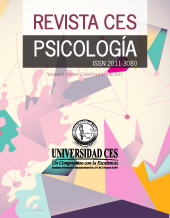Rasch Analysis of Cooperation Measure of the adolescent Orthodontic Patient in Medellin
DOI:
https://doi.org/10.21615/cesp.12.1.4Keywords:
Patient Compliance, Orthodontics, Adolescent, Validation StudiesAbstract
Introduction: Cooperation is a relevant therapeutic factor in achieving a successful orthodontic treatment result. In the case of adolescents, knowing cooperation level allows the orthodontist to consider behaviors and attitudes that contribute to treatment purposes. Objective: To Analyze the evidence of validity that measures collaboration in the orthodontic patient proposed by Slakter, Albino, Fox and Lewis in accordance with Wolfe and Smith´s guidelines. Methods: Validation study nested in a cohort study in which 132 adolescent patients under orthodontic treatment in Medellin Colombia were monitored between January 2014 and November 2015. It was estimated the locations and statistics for the adjustment of items, reliability, one-dimensionality and differential functioning by clinical and demographic characteristics of the participants. Wright's map is introduced. Results: Four items were removed from the scale. From the remaining six, a measure was obtained with a reliability of 0.74 and the capability to explain 74.9% of the variance. Differential functioning of the items was identified by type of malocclusion and interceptive orthodontic history. Conclusion: The validity of the measure is affected by limitations in constructing generalization according to relevant clinical characteristics of adolescents.
Downloads
References
Abu Alhaija, E. S., Aldaikki, A., Al-Omairi, M. K., & Al-Khateeb, S. N. (2010). The relationship between personality traits, pain perception and attitude toward orthodontic treatment. The Angle Orthodontist, 80(6), 1141-1149. doi: https://doi.org/10.2319/012710-59.1
Amado, J., Sierra, A. M., Gallón, A., Alvarez, C., & Baccetti, T. (2008). Relationship between personality traits and cooperation of adolescent orthodontic patients. The Angle Orthodontist, 78(4), 688-691. doi: https://doi.org/10.2319/0003-3219
Albino, JEN. (2000). Factors influencing adolescent cooperation in orthodontic treatment. Seminar Orthodontics, 6(4), 214-23.
Bland, J. M., & Altman, D. G. (1986). Statistical methods for assessing agreement between two methods of clinical measurement. Lancet, 1(8476), 307-310.
Bond, T. G., & Fox, C. M. (2015). Applying the Rasch model: fundamental measurement in the human sciences (Third edition New York and London: Taylor and Francis Group.
Bos, A., Hoogstraten, J., & Prahl-Andersen, B. (2005). Attitudes towards orthodontic treatment: a comparison of treated and untreated subjects. European Journal of Orthodontics, 27(2), 148-154. doi: https://doi.org/10.1093/ejo/cjh071
Canut, J. (2006) Pacientes descontentos y orotdoncistas disgustados. Revista Española Ortodoncia.36.165-168.
Daniels, A. S., Seacat, J. D., & Inglehart, M. R. (2009). Orthodontic treatment motivation and cooperation: a cross-sectional analysis of adolescent patients’ and parents’ responses. American Journal of Orthodontics and Dentofacial Orthopedics, 136(6), 780-787. doi: https://doi.org/10.1093/ejo/cjh07110.1016/j.ajodo.2007.11.031
Sackett D.L., Haynes, R.B., Guyatt, G.H., & Tugwell P. (1994). Epidemiología clínica Ciencia básica para la medicina clínica (2a. ed.). Madrid: Editorial Médica Panamericana
Engelhard, G. (2013). Invariant measurement: using Rasch models in the social, behavioral, and health sciences. New York: Routledge.
Escobar F. (2004). Odontología Pediátrica. Caracas, Venezuela: Editorial Actualidades Médico Odontológicas Latinoamérica.
Florenzano, R., & Zegers B. (2003). Psicología médica. Santiago, Chile: Mediterráneo.
Linacre, J. M. (2016). Winsteps® Rasch measurement computer program. (Versión 3.92.1). Beaverton, Oregon. Recuperado de www.winsteps.com
Linacre, J. M. (2002). Optimizing rating scale category effectiveness. Journal of Applied Measurement, 3(1), 85-106.
Mafla, A., Barrera, D., & Muñoz, G. (2011). Maloclusión y necesidad de tratamiento ortodóntico en adolescentes de Pasto, Colombia. Revista Facultad de Odontología Universidad de Antioquia, 22(2), 173-185.
Messick, S. (1995). Validity of psychological assessment: Validation of inferences from persons’ responses and performances as scientific inquiry into score meaning. American Psychologist, 50(9), 741-749.
Mtaya, M., Brudvik, P., & Astrøm, A. N. (2009). Prevalence of malocclusion and its relationship with socio-demographic factors, dental caries, and oral hygiene in 12- to 14-year-old Tanzanian school children. European Journal of Orthodontics, 31(5), 467-476. doi: https://doi.org/10.1093/ejo/cjn125
Nieto, J., Abad, M, Esteban, M., & Tejerina, M. (2004). Psicología para las ciencias de la salud. España: McGraw - Ineramercana editors.
Orozco Vargas, L. C., Villamizar Carvajal, B., & Vargas Porras, C. (2015). Impaired parenting in primiparous mothers: Clinical Validation through Rasch Analysis. Aquichan, 15(2), 176-182.
Sarul, M., Kawala, B., Kozanecka, A., Łyczek, J., & Antoszewska-Smith, J. (2017). Objectively measured compliance during early orthodontic treatment: Do treatment needs have an impact? Advances in Clinical and Experimental Medicine, 26(1), 83-87. doi: https://doi.org/10.17219/ACEM/62107
Skidmore, K. J., Brook, K. J., Thomson, W. M., & Harding, W. J. (2006). Factors influencing treatment time in orthodontic patients. American Journal of Orthodontics and Dentofacial Orthopedics, 129(2), 230-23. doi: https://doi.org/10.1016/j.ajodo.2005.10.003
Slakter, M. J., Albino, J. E., Fox, R. N., & Lewis, E. A. (1980). Reliability and stability of the orthodontic Patient Cooperation Scale. American Journal of Orthodontics, 78(5), 559-563.
Spalj, S., Slaj, M., Varga, S., Strujic, M., & Slaj, M. (2010). Perception of orthodontic treatment need in children and adolescents. European Journal of Orthodontics, 32(4), 387-394. doi: https://doi.org/10.1093/ejo/cjp101
Thissen, D., Steinberg, L., & Kuang, D. (2002). Quick and Easy Implementation of the Benjamini-Hochberg Procedure for Controlling the False Positive Rate in Multiple Comparisons. Journal of Educational and Behavioral Statistics, 27(1), 77-83.
Tervonen, M-M., Pirttiniemi, P., & Lahti, S. (2011). Development of a measure for orthodontists to evaluate patient compliance. American Journal Orthodontic Dentofacial Orthopedic, 139(6), 791-6.
Wolfe, E. W., & Smith, E. V. (2007). Instrument development tools and activities for measure validation using Rasch models: part II--validation activities. Journal of Applied Measurement, 8(2), 204-234. doi: https://doi.org/10.1016/j.ajodo.2009.10.045
Downloads
Published
How to Cite
Issue
Section
License
Copyright (c) 2018 CES Psicología

This work is licensed under a Creative Commons Attribution-NoDerivatives 4.0 International License.
Each manuscript is accompanied by a statement specifyingThat the materials are unpublished, that have not been previously published in printed formatElectronic and that they will not be presented to any other means before knowing the decision of the magazine. ThroughoutIn case, any previous publication, sea in printed or electronic form, must be made known to the editorial staffWriting The authors attach a signed statement stating that, and the manuscript is acceptedFor publication, the rights of reproduction are the exclusive property of the Journal CES Psychology.| Article metrics | |
|---|---|
| Abstract views | |
| Galley vies | |
| PDF Views | |
| HTML views | |
| Other views | |




